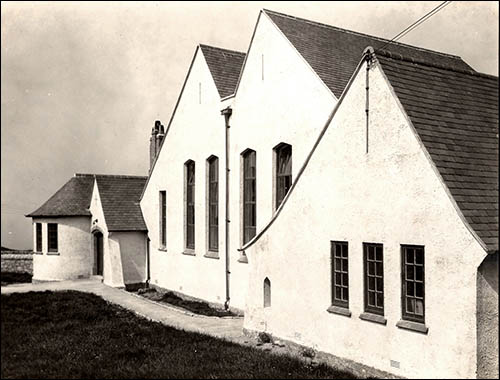St Cynfran’s Church and well, Llysfaen
According to tradition, a religious cell was founded here in 777AD. Clwyd-Powys Archaeological Trust has suggested that a raised earth bank, north of the church, could be the remains of an ancient llan (walled enclosure around a cell).
The church is dedicated to St Cynfran, reputedly one of the sons of Brychan Brycheiniog in the fifth century. One of his brothers was Cynbryd, patron saint of neighbouring Llanddulas parish. Cynfran came to be regarded as patron saint of cattle.
A holy well known as Ffynnon Gynfran (Cynfran’s Well) is located c.100m north of the present church, and it’s said that Cynfran baptised a convert there soon after he first preached in this area. The well was still supplying the holy water for the church font into the 20th century but later became derelict. Local people would pray to Cynfran at the well on the eve of his saint’s day, 12 November, asking him to bless their livestock.
Church tax records from 1254 refer to the church as Ecc’a de Llesvaen. The north nave of the existing church building may date from that century. The south nave was added later. The church was renovated in the 1870s, when the bellcote, porch, buttresses were added and the rood screen and windows rebuilt.
 In 1915 the rector of Llysfaen, Rev David Lewis, lost his son, Rev Ivor Morgan Lewis, in the First World War. Ivor, aged 26, was serving as chaplain on HMS Goliath when it was torpedoed during the ill-fated invasion of Gallipoli, Turkey. Ivor was one of c.570 who died on the battleship and is named on the war memorial in the churchyard.
In 1915 the rector of Llysfaen, Rev David Lewis, lost his son, Rev Ivor Morgan Lewis, in the First World War. Ivor, aged 26, was serving as chaplain on HMS Goliath when it was torpedoed during the ill-fated invasion of Gallipoli, Turkey. Ivor was one of c.570 who died on the battleship and is named on the war memorial in the churchyard.
The Welsh tradition of “canu Plygain” (or “Plygam” in North Wales) continued here into the 20th century. The name comes from the Latin for cock crow, pulli cantus, and the ceremony involved worship and singing at first light on Christmas morning. In 1915, for example, a choir of over 50 children sang 15 carols – starting at 6am!
The nearby church hall (pictured) was designed by Sidney Colwyn Foulkes and built c.1929. Unlike his brick church halls in Glan Conwy and Old Colwyn, this one is roughcast and is very much in the style of Herbert North’s Church Institute in Llanfairfechan.
With thanks to Adam Voelcker


